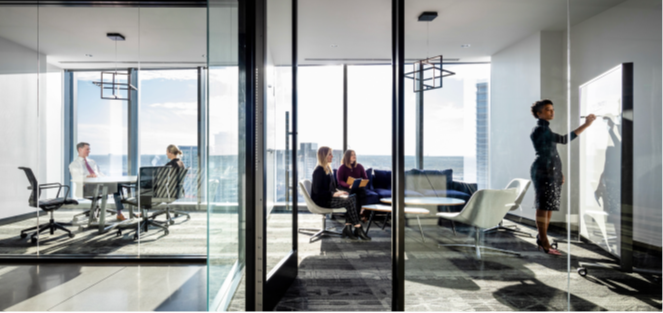
By Billy Gannon, Transwestern, and Dr. Michael Gao, Haven Diagnostics
The re-evaluation of office space, and the importance of the workspace, has been something the business world has never seen to the extent it has this year. Trends that were already occurring, like remote work, were thrown into the limelight thanks to the onset – and continuation – of the COVID-19 pandemic. That leads to many companies asking the question: “What does the future of the office really look like?”
The office does not have to be binary: a real estate strategy does not have to be full-time remote, or full-time in the office. In fact, prior to COVID-19, Gallup estimated 43{ff66251fa959225ec0415bec498104472c710c05756e34120ff9c6ac4cef9161} of employees worked remotely with some frequency in schedules already, and because of employees’ need for flexibility, a hybrid work model might make sense.
After COVID-19 passes and with the development of vaccines, regardless of how much office space tenants decide to utilize, the following three things should always be a part of sophisticated real estate strategies.
Safe Environments that Foster Creativity
According to Convene, work environments have a direct impact on morale and productivity. As employees suffer work-from-home fatigue, co-working locations are implementing on-demand hours to match the need for flexibility. Creative spaces that inspire are here to stay as they can lead to imagination that positively impacts the quality of work.
Productive Space to Accomplish Tasks
One report from enterprise software company Aternity labeled remote work as a productivity tax, noting “85{ff66251fa959225ec0415bec498104472c710c05756e34120ff9c6ac4cef9161} are still away from the office and overall productivity has dropped by 14{ff66251fa959225ec0415bec498104472c710c05756e34120ff9c6ac4cef9161}.” Odds are full-time remote workers are not spending hours a day in the comfort of their own beds. They are putting together at-home desks with dual monitors, probably in a quiet part of the residence. Why? Because early on, it became clear that working from kitchen counters and the comfort of the bedroom made tasks that usually would have been easy in the office more challenging. Distractions were more frequent, the fridge was closer, and the kids kept screaming. The office allows for an employee’s “desk” to be their own workplace, with the required privacy, storage, and technology at their fingertips. Additionally, employees working from home are putting businesses at a higher risk of cyberattacks, according to a recent study by CyberArk. Despite the additional security risks posed by the rise in remote working, the study found that “57{ff66251fa959225ec0415bec498104472c710c05756e34120ff9c6ac4cef9161} of IT professionals surveyed said they have not increased security protocols.”
In-Person Collaboration for Team Building
Since the beginning of time, humans have come together through in-person experiences. Whether this be a place of worship, sports stadium, movie theater or crowded restaurant, coming together enhances the overall experience. This is true for office space, as the designated location acts as a home base for colleagues to feel like members of a team, where ideas and contributions are heard and appreciated. According to a study, MIT found that the amount of in-person interaction among co-workers had a substantial impact on performance.
Measuring and understanding in-office transmission risk from COVID-19 is vital to returning to a safe work environment. Originally developed to solve infectious disease outbreaks within hospitals, Haven Diagnostics helps employers understand their workplace’s in-office COVID-19 and infectious disease risk with a medical analytics report. Transwestern helps companies develop a real estate strategy that supports productivity, which leads to company success.
Rather than speculating that full-time remote work is the answer, companies are now understanding that it is part of a broader real estate strategy. Returning to the office during COVID-19 can be challenging, so remember to make scientific- and data-driven decisions for your company’s long-term needs.
Billy Gannon is Senior Vice President at Transwestern. He is a Dallas native and has been in the real estate industry since 2004. Billy graduated from Southern Methodist University with BBA in Finance.
Michael Gao, M.D., is CEO and Medical Director at Haven Diagnostics, a medical analytics company specializing on workplace health risk. Dr. Gao was previously Director for Transformation overseeing Applied Artificial Intelligence at New York-Presbyterian and is currently on faculty (honorary) at Weill Cornell.

